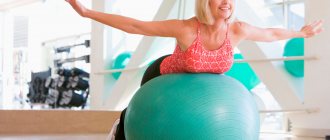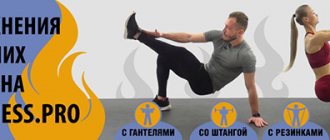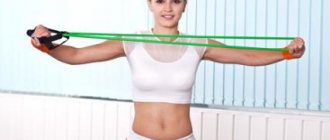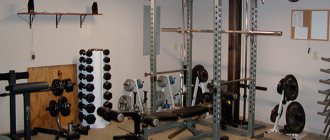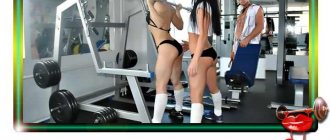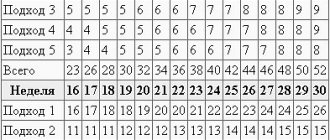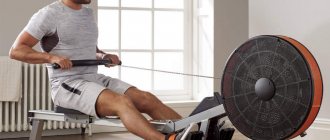Training technology[edit | edit code]
Beginners should not start training each muscle separately, as such an approach contributes to improper general physical development, and in some cases even harms health. We suggest performing basic exercises, i.e. those that engage many muscles at once and that target the largest muscle groups. These exercises are squats, deadlifts and bench presses. Start working with weights that you can perform 15-20 repetitions with. Avoid failure approaches—beginners don't need them. This is one of the most effective methods for general physical training for a beginner. It is this approach that lays the foundation for your beautiful and strong body.
The main task of a bodybuilder who wants to start training is to create the basis for further training, namely: to accustom the body to regular loads, if possible, strengthen the ligaments and increase overall muscle strength. To do this, beginner athletes should focus their main efforts on basic exercises. More experienced bodybuilders are more suitable for isolation exercises, which allow them to give their muscles expressive, refined shapes.
Each exercise of the complex must be learned to be performed absolutely correctly (preferably under the guidance of a trainer or a more experienced friend). As a last resort, use photo or video materials.
To get comfortable with the technique of performing an unfamiliar exercise, you need to do it first without weight, which will help the novice athlete avoid injuries in the future.
When performing exercises in a standing position, you should keep your head straight, your back should be arched slightly, your legs should be shoulder-width apart, your gaze should be directed straight ahead.
The load must be increased gradually. At the initial stage, it does not make sense to work until the muscles completely fail, but over time this should become a habit.
When starting to train, it is advisable to first work out large muscle groups (legs, back, chest): they require more energy expenditure and significant psychological stress, so it is better to work on them with fresh strength. In the second half of the training, you can move on to working in small groups.
For the first 2-3 months, you don’t have to change the schemes you will use to train, but at the end of this period, the muscles, having gotten used to this complex, can stop the process of increase. If this happens, you need to change the exercise pattern, their order, the number of sets-repetitions, as well as the rest time between sets. This will not allow the muscles to adapt to the usual load, and they will continue to grow.
During the training process, the psychological attitude of the athlete is of great importance. He must constantly mentally concentrate on the work of the muscles, imagining that they are all increasing in size and becoming stronger every minute.
Where to start training?
Most people nowadays go in for sports in order to have a beautiful, athletic and fit figure. It doesn’t matter what dictates this desire, the main thing is that it is there and it intensifies on the eve of the beach season, when everyone begins to go on diets and actively train. The understanding that you have neglected yourself and it’s time for you to take care of your figure comes the moment you look at yourself in the mirror. The understanding that it is time and the realization that things will only get worse serve as the foundation for making a decision. It is with the decision that your training begins. And so you stood in front of the mirror and looked at yourself objectively, but most likely critically, because we can’t be objective towards ourselves and made a decision, I’m starting everything!
After the decision is made, many begin to go crazy, start running in the morning, run to the gym, to the pool, etc. not understanding what it will give them and why they are doing it, the only thing they receive is moral satisfaction, because they have made a decision and they are faithful to it. But it's not right.
Once you decide that you are starting to exercise, you need to decide on the goal of what exactly you want to achieve with training. Get rid of excess weight or maybe build muscle mass? Formulate for yourself a clear goal that you want to achieve. How you eat, how you train , how intensely and where this will happen will depend on your goal. And so, the decision has been made, the goal has been set, but how to start training correctly?
Diary of an aspiring bodybuilder[edit | edit code]
Main article:
Training Diary
Every bodybuilder should constantly record his condition. To do this, you need to keep a diary where data on the physical and mental state of the athlete is entered daily. The overall picture of the condition consists of 6 components:
- health (good, satisfactory, unsatisfactory);
- sleep (strong, intermittent, lack of sleep);
- performance (high, medium, low);
- appetite (good, satisfactory, poor);
- heart rate (should return to normal 5-7 minutes after the next exercise; the norm is 60-80 beats per minute, after a light load - 90-110, after a medium load - up to 120, after a heavy load - up to 160 or more);
- breathing rate (should return to normal 2-3 minutes after the next exercise; normal - 15-18 breaths per minute, after exercise - 60-70 breaths)
- desire to train (great, indifferent, lack of desire).
Classification of exercises[edit | edit code]
Main article:
Types of exercise
All exercises in bodybuilding can be divided into two main types:
- multi-joint (basic), during which several muscles work at once (squats);
- single-joint (isolating), which load only one muscle (lifting a barbell for biceps).
Beginning athletes should focus on basic exercises, since they allow them to develop several muscles at the same time, which is necessary to quickly overcome initial detraining. It will also lay the foundation for future heavy weight training.
But even when performing basic exercises, one muscle receives the most intense load. For example, during a squat, the quadriceps work mainly and, to a much lesser extent, the biceps of the lower leg, thighs, buttocks and back muscles.
Repetitions[edit | edit code]
Main article:
Repetition
Repetition in bodybuilding refers to performing a specific exercise once. If, for example, an athlete lifts a barbell 10 times in a row, then we can say that he performs 10 repetitions.
As already mentioned, at first you need to use a light weight, performing a significant number of repetitions (15-20) strictly technically, which will allow the novice athlete to master the technique of performing the exercise and controlling muscles. After 2 weeks of such training, you can reduce the number of repetitions to 8-12 in the main set and to 15 in the warm-up (at the beginning of each exercise). In this case, you need to select the weight in such a way as to be able to technically perform the specified number of repetitions, and also to bring the muscles to a state in which it is not possible to perform a single repetition incorrectly from a technical point of view.
If you cannot technically perform 8 repetitions, the weight should be reduced, but if a beginner can easily perform more than 12 repetitions, the weight should be increased.
Practice has shown that working with a weight that is 70% of the maximum leads to optimal results. The maximum weight in bodybuilding is the weight at which an athlete can technically perform one repetition.
Sets (approaches)[edit | edit code]
Main article:
Seth
In bodybuilding, a set is a series of repetitions of one specific exercise.
For a beginning athlete, it is advisable to start each exercise with 2 warm-up sets for each muscle group (with light weight), and then perform 1-3 sets with maximum weight. The result is 3-5 approaches for each exercise.
Lifehacks
Use special reading techniques. Everyone has practiced in-depth reading and reading-scanning at least once in their life; there should be no problems here. There are differing views on speed reading. Practice shows that you can do without it, but to increase your efficiency, try to master this method. You will be helped by specialized applications based on spritz technologies (words are displayed on the screen one at a time to reduce the time it takes your eyes to move through lines) and Blankist (the program splits texts into parts, each containing the main idea, which you can read in just a couple minutes). To speed up your work, learn to type quickly. There are many programs for developing this skill: “Keyboard Solo” - for Windows, KeyKey - for Mac OS, or the online trainer “All10”. One final piece of advice: Always consider at least seven options when choosing anything, be it a refrigerator or a career path.
You can learn other life hacks for quick and high-quality information analysis at the Changellenge School >>. During the 21-day educational intensive, you will understand other stages of solving business problems: from formulating a problem to defending a project in front of clients.
Find out more >>
A 21-day educational intensive, created according to MBA principles, will pump you up for a cool career. You will find four cases from different industries: banking, consulting, IT, FMCG, 20 experts with MBA diplomas and more than 100 useful contacts. Hurry up to apply!
Find out more >>
We recommend:
- How to discover working hypotheses
- Searching as an art: where and how to look for information correctly
- How to find an expert and collect quality information
Technique for determining optimal weight[edit | edit code]
Main article:
How to determine working weight
When starting to train, it is better to use minimal weight in order to feel the work of one or another muscle group and learn how to perform the exercise correctly. After a couple of weeks you need to increase the load a little.
But for the 1st set it is better to still use light weight. Even experienced athletes do the first set of exercises of 16-20 repetitions with ultra-light weights or no weight at all, so that the muscles and connective tissues involved in the exercise warm up and fill with blood.
For the 2nd set (10-12 repetitions) you need to add a couple of small pancakes. If you managed to do this without much difficulty and at the same time strictly followed the technique of performing the exercise, you need to further increase the weight. If the same 12 repetitions are performed again with the correct technique, you need to increase the weight again, but just a little.
A gradual increase in weight with each new set is called a pyramid - this is one of the safest methods of training.
Weight is added until 8-12 repetitions are given to you with enormous difficulty. Thus, having determined the optimal weight, in the future you need to train with it, so that after 8-12 repetitions the muscles refuse to work. The weight can be increased again only when the athlete's strength has increased and he can increase the number of repetitions. If this happens, you can increase the weight by 10%. The athlete may not be able to cope with this new weight at first, that is, he will not be able to perform 12 repetitions, but this will definitely happen after some time. Using this scheme (it’s called the “overload principle”) you can continue to train. The point of this principle is to regularly give the muscles a load slightly higher than what they are accustomed to. In response, the muscles begin to accumulate protein in the cells, that is, they become larger and stronger. The usual load does not give such an effect.
In order to monitor your achievements, you need to keep another diary - a training diary.
A typical mistake of novice bodybuilders is the desire to lift more weight, helping themselves with their whole body. This should not be done. Bodybuilding and weightlifting are two different things. The bodybuilder’s task is not to gain weight, but to build a harmonious, proportional body.
It is better to take less weight and perform the exercise flawlessly than to swing at an exorbitant weight and make poor technique, which will sooner or later lead to injury.
What is sport and how does it happen?
We all know very well the common expressions “sport is life”, “sport is movement”, “sport is health” and here we will not discover America, this is a fact. In fact, this capacious concept hides something more than running at a stadium or working out in a gym. Every person who plays sports can probably formulate his own definition of this concept. If you decide to take up sports in any of its forms, you will have to change almost everything in your life, from your outlook on life in general to the way you dress. The changes that will occur are not rules established by someone, but a natural process that is a consequence of the fact that you decided to start leading an active lifestyle. They will come gradually as you move towards your goal. You will have to learn all aspects of the sport if you want to achieve any results.
Before you start actively playing sports, you need to understand that sports can be different, that is, sports can be professional and amateur. Professionals and amateurs are fundamentally different categories of athletes and their difference is that both categories have completely different views on training , a different approach to training, and different capabilities. Now many will say that we know this perfectly well without you, but, nevertheless, many, or even better, the majority, look at famous athletes and try to repeat what they do, this is wrong. After all, what these athletes are doing is something they have been doing for years and through the hardest training, and the majority, two weeks after the start of classes, come to the gym, swimming pool, stadium, etc., and try to repeat partially or completely their training program, this is a gross mistake. . Therefore, it is important to clearly understand the difference between professional and amateur sports.
Speed of exercise[edit | edit code]
Main article:
Exercise speed
In the process of performing exercises, all movements must be done without haste (it is moderate speed that gives the best results in bodybuilding) and under constant control of consciousness. Under no circumstances should they be performed mechanically.
The following speed formula has worked well:
- 2 seconds to lift the weight;
- instant muscle tension at the top point;
- 2 seconds to lower the weight.
Tips for beginners[edit | edit code]
The main task of a beginner
— strengthen ligaments, increase overall muscle strength and accustom the body to regular exercise. Therefore, the main efforts of novice athletes should be focused on basic exercises. Isolation exercises are intended for more experienced bodybuilders who are engaged in giving their muscles refined, expressive forms. A new exercise must first be done without weight to become familiar with its technique. Incorrect technique can lead to injury.
When performing exercises in a standing position, you need to keep your head straight, bend your back slightly, and your feet should be shoulder-width apart. The gaze should be directed straight ahead.
When you just started training, you shouldn’t immediately work until your muscles completely fail, but you still need to approach this state.
You can't stand still between sets - it's best to stretch. This not only develops flexibility, but also speeds up recovery before the next set. When stretching, you should not make jerks or sudden movements.
First, large muscle groups are worked out (legs, back, chest), after which small ones are activated. The former require more energy expenditure and mental effort, so it is more advisable to work on them with fresh forces.
For the first 2-3 months, it is advisable to train according to the same scheme. But at the end of this period, the muscles will get used to this complex and may stop responding to it with growth. In this case, you should change the exercises, their order, the number of sets-repetitions and rest time between sets. This will prevent the muscles from adapting to the load, and they will begin to grow again.
During training, you need to concentrate on the work of the muscles, try to feel each working muscle, imagining that it is becoming bigger and stronger every minute.
How long should you exercise to reap health benefits?
Of course, it all depends on your initial physical fitness, your health, weight, and other factors. Here are some general recommendations for those who decide to start training.
Cardio (minimal activity): At least 150 minutes of moderate cardio throughout the week. This can be replaced with at least 75 minutes of intense cardio throughout the week or a combination of both.
Strength training (highly recommended): Exercises involving major muscle groups - 2 or more days per week.
For additional health benefits: Minimum cardio should be increased by an additional 300 minutes per week (moderate) or 150 minutes (intense) cardio per week (or a combination of both).
While this may seem like a lot, you can customize your workouts to fit your schedule. If the cardio exercise is done for at least 10 minutes, you can divide the active minutes into as many workouts as you need per week.

